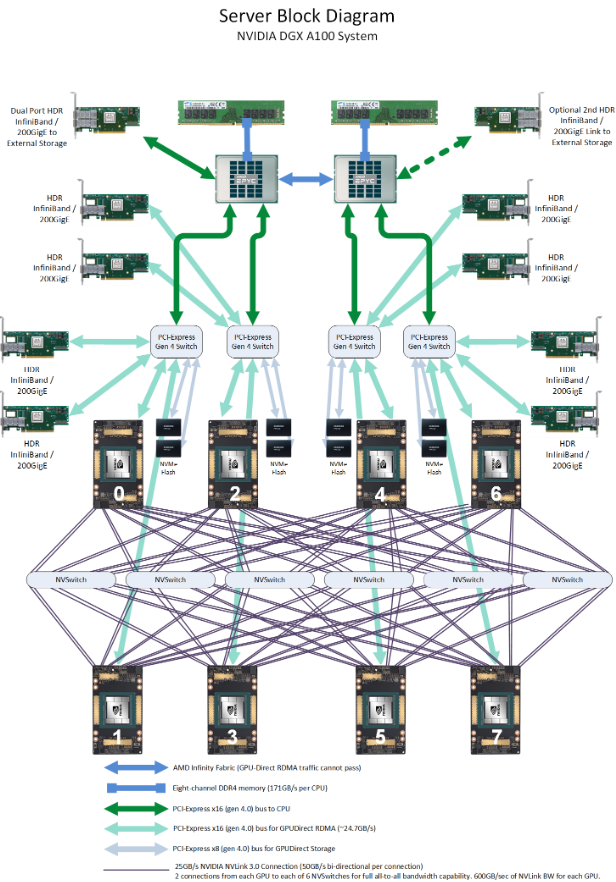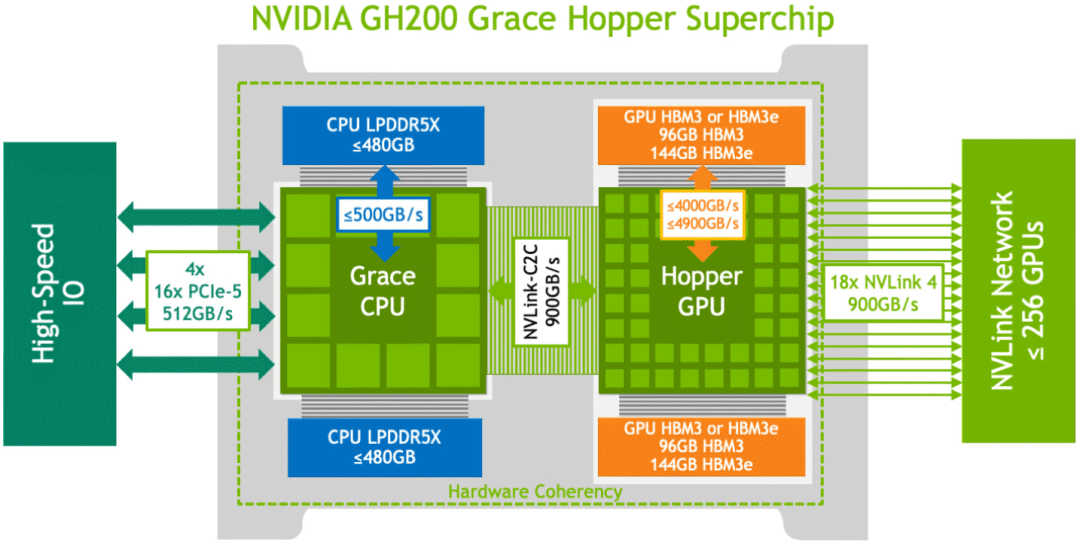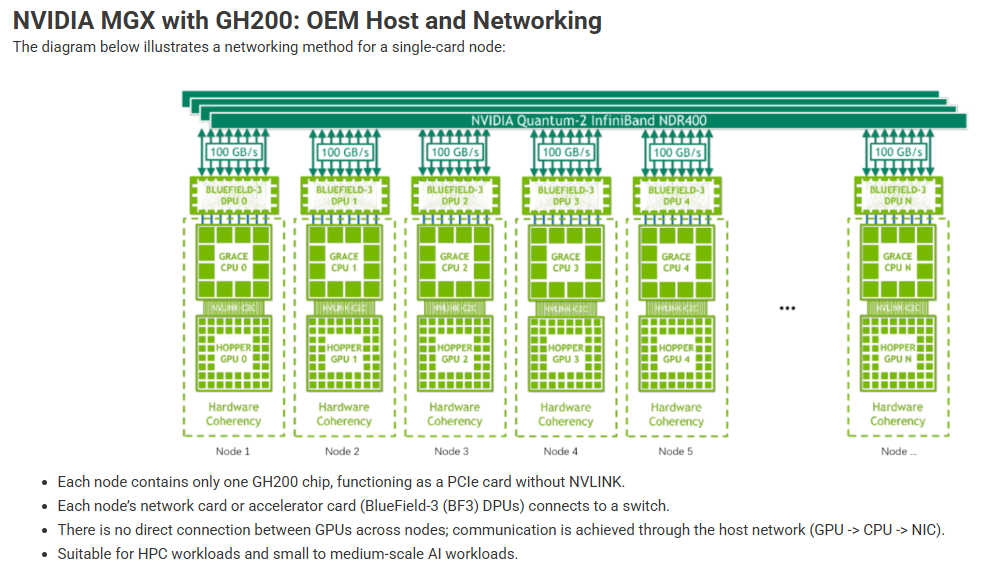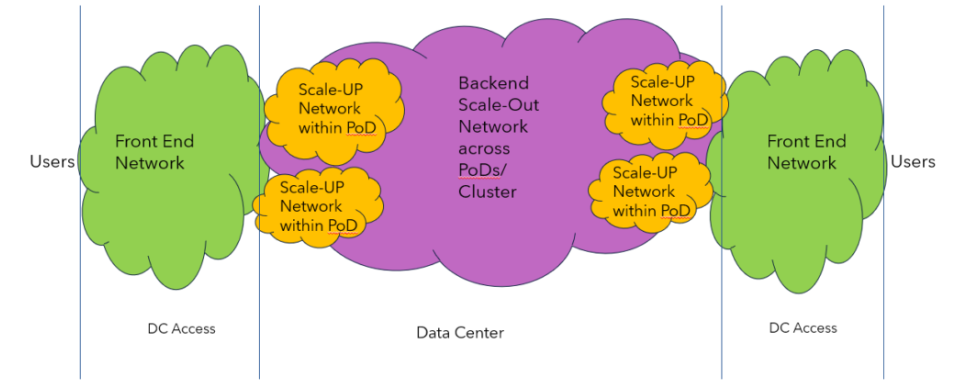Examples
These examples demonstrate describing a variety of devices and infrastructures using text descriptions and diagrams to defining them using a standardized schema.
DGX-A100 Server
This server diagram acts as an example of how multiple components can be connected to a single component such as multiple gpu components are connected to a single pcie switch.
The graph model is able to capture the asymmetric layout of the device.
Description

Standardized Definition
DGX device definition using OpenApiArt generated classes
from typing import Optional
from infragraph import *
# pyright: reportArgumentType=false
class Dgx(Device):
def __init__(self, nic_device: Optional[Device] = None):
"""Adds an InfraGraph device to infrastructure based on the following components:
- 2 cpus
- 8 npus
- 4 pcie switches
- 8 nics
- 1 nvlink switch
"""
super(Device, self).__init__()
self.name = "dgx"
self.description = "Nvidia DGX System"
cpu = self.components.add(
name="cpu",
description="AMD Epyc 7742 CPU",
count=2,
)
cpu.choice = Component.CPU
xpu = self.components.add(
name="xpu",
description="Nvidia A100 GPU",
count=8,
)
xpu.choice = Component.XPU
nvlsw = self.components.add(
name="nvlsw",
description="NVLink Switch",
count=1,
)
nvlsw.choice = Component.CUSTOM
pciesw = self.components.add(
name="pciesw",
description="PCI Express Switch Gen 4",
count=4,
)
pciesw.choice = Component.CUSTOM
if nic_device is None:
nic = self.components.add(
name="nic",
description="Generic Nic",
count=8,
)
nic.choice = Component.NIC
else:
nic = self.components.add(
name=nic_device.name,
description=nic_device.description,
count=8,
)
nic.choice = Component.DEVICE
cpu_fabric = self.links.add(name="fabric", description="AMD Infinity Fabric")
pcie = self.links.add(name="pcie")
nvlink = self.links.add(name="nvlink")
edge = self.edges.add(scheme=DeviceEdge.MANY2MANY, link=cpu_fabric.name)
edge.ep1.component = cpu.name
edge.ep2.component = cpu.name
edge = self.edges.add(scheme=DeviceEdge.MANY2MANY, link=nvlink.name)
edge.ep1.component = xpu.name
edge.ep2.component = nvlsw.name
for npu_idx, pciesw_idx in zip(["0:2", "2:4", "4:6", "6:8"], range(pciesw.count)):
edge = self.edges.add(scheme=DeviceEdge.MANY2MANY, link=pcie.name)
edge.ep1.component = f"{xpu.name}[{npu_idx}]"
edge.ep2.component = f"{pciesw.name}[{pciesw_idx}]"
for nic_idx, pciesw_idx in zip(["0:2", "2:4", "4:6", "6:8"], range(pciesw.count)):
edge = self.edges.add(scheme=DeviceEdge.MANY2MANY, link=pcie.name)
edge.ep1.component = f"{nic.name}[{nic_idx}]"
edge.ep2.component = f"{pciesw.name}[{pciesw_idx}]"
if __name__ == "__main__":
device = Dgx()
print(device.serialize(encoding=Device.YAML))
DGX device definition as yaml
components:
- choice: cpu
count: 2
description: AMD Epyc 7742 CPU
name: cpu
- choice: xpu
count: 8
description: Nvidia A100 GPU
name: xpu
- choice: custom
count: 1
description: NVLink Switch
name: nvlsw
- choice: custom
count: 4
description: PCI Express Switch Gen 4
name: pciesw
- choice: nic
count: 8
description: Generic Nic
name: nic
description: Nvidia DGX System
edges:
- ep1:
component: cpu
ep2:
component: cpu
link: fabric
scheme: many2many
- ep1:
component: xpu
ep2:
component: nvlsw
link: nvlink
scheme: many2many
- ep1:
component: xpu[0:2]
ep2:
component: pciesw[0]
link: pcie
scheme: many2many
- ep1:
component: xpu[2:4]
ep2:
component: pciesw[1]
link: pcie
scheme: many2many
- ep1:
component: xpu[4:6]
ep2:
component: pciesw[2]
link: pcie
scheme: many2many
- ep1:
component: xpu[6:8]
ep2:
component: pciesw[3]
link: pcie
scheme: many2many
- ep1:
component: nic[0:2]
ep2:
component: pciesw[0]
link: pcie
scheme: many2many
- ep1:
component: nic[2:4]
ep2:
component: pciesw[1]
link: pcie
scheme: many2many
- ep1:
component: nic[4:6]
ep2:
component: pciesw[2]
link: pcie
scheme: many2many
- ep1:
component: nic[6:8]
ep2:
component: pciesw[3]
link: pcie
scheme: many2many
links:
- description: AMD Infinity Fabric
name: fabric
- name: pcie
- name: nvlink
name: dgx
GH200-MGX
Description
XPU Component

Device

Standardized Definition
ScaleUp/ScaleOut Infrastructure
Description
 https://mips.com/blog/reimagining-ai-infrastructure-the-power-of-converged-back-end-networks/
https://mips.com/blog/reimagining-ai-infrastructure-the-power-of-converged-back-end-networks/
- 1024 hosts
- 1 xpu/host
- 10 nics/host
- 512 scaleup switches
- 16 ports/switch
- 2 scaleout switches
- 1024 ports/switch
- 64 Racks
- 16 hosts/rack
- 8 scale up switches/rack
